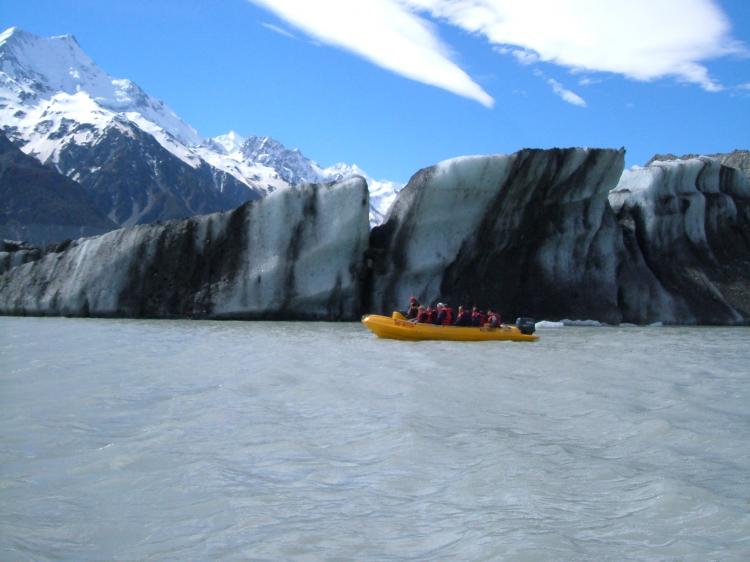A 30 million ton iceberg sheered off the Tasman Glacier in Aoraki Mt. Cook National Park shortly after the 6.3-magnitude quake that hit Christchurch, about 200 kilometers (125 miles) away on Tuesday, Feb. 22.
The 1.2-km long, 300-meter high, 25-meter wide (0.75 mile, by 984-foot, by 82 foot) block of ice crashed into Tasman Glacier Terminal Lake, creating waves up to 3.5 meters (11 feet) high for the next 30 minutes, with an accompanying sound like a loud rifle fire, AAP reported.
Denis Callesen, Aoraki Mt. Cook Alpine Village tourism general manager, told the New Zealand Herald that huge icebergs formed in the lake, and people on two passenger boats had the trip of a lifetime.
“We have procedures to deal with this type of event and for some time have stayed 800 meters [0.5 miles] away from the Terminal Face as we suspected it was becoming unstable,” he said.
Callesen said this was the third largest calving [breaking] event in the last 40 years of the lake’s history, adding that the massive aftershock was the first quake felt at Aoraki Mt. Cook since the September 2010 quake.
The ice broke up in the water, forming several icebergs, one 250 meters (820 feet) long.
The Tasman Glacier is the longest in New Zealand, and its face has moved around 60 meters (197 feet) above the surface of the lake due to the event, according to TVNZ.
However, the Department of Conservation (DOC) said it was arguable whether the earthquake “precipitated” the calving, according to AFP, as locals have been expecting the glacier to drop a major iceberg for the past month.
DOC area manager Richard McNamara told AFP that the iceberg would have popped up in the water like a “porpoise” before fragmenting into smaller chunks.
“It calved in one big lot; a face about a kilometer long calving is a spectacular sight,” McNamara said.
The 1.2-km long, 300-meter high, 25-meter wide (0.75 mile, by 984-foot, by 82 foot) block of ice crashed into Tasman Glacier Terminal Lake, creating waves up to 3.5 meters (11 feet) high for the next 30 minutes, with an accompanying sound like a loud rifle fire, AAP reported.
Denis Callesen, Aoraki Mt. Cook Alpine Village tourism general manager, told the New Zealand Herald that huge icebergs formed in the lake, and people on two passenger boats had the trip of a lifetime.
“We have procedures to deal with this type of event and for some time have stayed 800 meters [0.5 miles] away from the Terminal Face as we suspected it was becoming unstable,” he said.
Callesen said this was the third largest calving [breaking] event in the last 40 years of the lake’s history, adding that the massive aftershock was the first quake felt at Aoraki Mt. Cook since the September 2010 quake.
The ice broke up in the water, forming several icebergs, one 250 meters (820 feet) long.
The Tasman Glacier is the longest in New Zealand, and its face has moved around 60 meters (197 feet) above the surface of the lake due to the event, according to TVNZ.
However, the Department of Conservation (DOC) said it was arguable whether the earthquake “precipitated” the calving, according to AFP, as locals have been expecting the glacier to drop a major iceberg for the past month.
DOC area manager Richard McNamara told AFP that the iceberg would have popped up in the water like a “porpoise” before fragmenting into smaller chunks.
“It calved in one big lot; a face about a kilometer long calving is a spectacular sight,” McNamara said.






